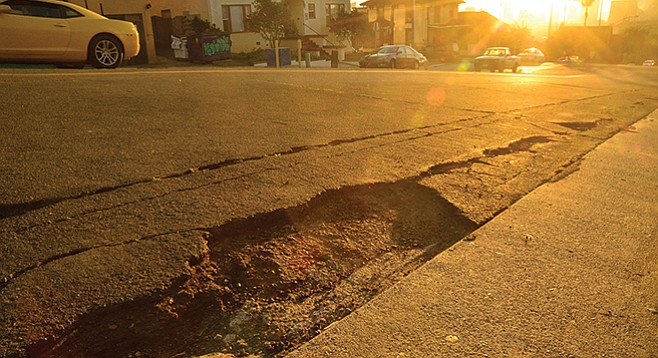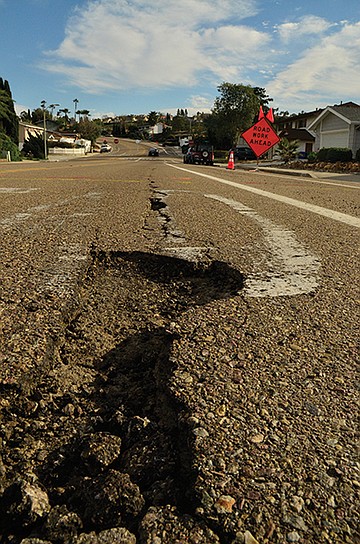 Facebook
Facebook
 X
X
 Instagram
Instagram
 TikTok
TikTok
 Youtube
Youtube

On C Street in San Diego’s Golden Hill neighborhood, cracks in the asphalt meander like fault lines. Near C Street’s intersection with 23rd Street, in a block where single-family homes are valued anywhere from $750,000 to $1.2 million, jagged chunks of asphalt resembling stone tools used by early man lie next to car-crippling potholes.

Ten miles away, on Golfcrest Drive near the base of Cowles Mountain in San Diego’s San Carlos neighborhood, a crack in the pavement runs for several blocks. Every dozen or so feet, the fissure runs into a soccer-ball-sized hole in the pavement.
San Diego’s roads, only 40 percent of which are rated in fair condition, are crumbling at a faster-than-usual rate after multiple storms dropped several inches of rain on San Diego in January of this year. The streets are causing damage to vehicles and pose a hazard for cyclists.
During the strongest succession of storms, over the five-day span from January 16 through January 21, a city spokesperson says, the city received 1300 notifications of new potholes. Since the beginning of the year, says the spokesperson, there have been a total of 6859 requests for pothole repair.
The majority of complaints originated from council districts 2, 3, and 6, among the city’s most densely populated areas, including downtown, Ocean Beach, Pacific Beach, Mission Beach, Golden Hill, North Park, Hillcrest, Clairemont, and Kearny Mesa.
Descriptions of the potholes left on the city’s website show the extent of the problem.
In a February 8 request, posted to the City of San Diego, a resident writes of “at least 20 potholes on the stretch of road, Carrol Road between Camino Santa Fe and Miramar. It’s so dangerous to drive, everyone just swerves in the other lanes to avoid all the potholes. This needs immediate attention, someone is going to get killed on this stretch of road.”
One Clairemont resident wrote in a February 3 complaint of “Another pothole that has bent and now broke [one] of my rims. I want my rims fixed this is ridiculous.”
A man in La Jolla wrote to inform the city of a large pothole in La Jolla. “Large pothole in this area caused a flat tire on my vehicle. I hit the pothole during the evening when it was raining which made it difficult to see and therefore unavoidable.”
In a January 2015 report, city staff identified $580 million needed for street and road-pavement repairs and modification projects, or 15 percent of the city’s $3.9 billion infrastructure backlog. The dollar amount increases when factoring in repairs to sidewalks and the addition of bike lanes.
San Diego’s roads have been in disrepair for years. According to a 2016 road-assessment survey, 60 percent, or 1800 miles out of San Diego’s 3000 miles of paved streets, were considered to be in “good condition,” whereas 34 percent, or 1020 miles, received a fair grade. Last year, road crews filled approximately 33,000 potholes, according to city numbers provided to the Reader.
Despite the average numbers, city officials and mayor Kevin Faulconer lauded the report. Just five years earlier, in 2011, engineers identified only 35 percent of San Diego’s roads to be in good condition.
“We’re going in the right direction, but we still have roads that need fixing,” Faulconer told a city-council committee in September 2016. “It’s a quality-of-life issue. Whether you are driving your car or riding your bike, San Diegans deserve good roads.”
In an effort to address the problem of crumbling streets, Faulconer has set aside $109 million in fiscal year 2017’s budget with promises to repair 1000 miles of streets over the course of the next five years.
Despite the improvement, the fact is that 40 percent of San Diego’s streets are in poor condition. That much has been evident in the growing number of lawsuits filed by pedestrians and cyclists hurt as a result of San Diego’s poor road conditions. According to city data, the city has paid nearly $667,000 in legal settlements for pedestrians and cyclists injured on city streets. Most recently, in December 2016 the city agreed to pay $235,000 to cyclist Cathleen Summerford who suffered serious injuries after running into a 3-inch-by-15-inch pothole on Torrey Pines Road in La Jolla.
Settlements and legal payouts will not end anytime soon. Trials in other cases involving potholed city streets are scheduled for later this year.
Samantha Ollinger, executive director of the nonprofit advocacy group BikeSD, criticized the city for taking a response-driven approach to repairing San Diego roads and having to shell out hundreds of thousands of dollars in legal settlements that could have been spent making sure roads were safe.
“I hate to state the obvious, but this is completely avoidable — both the dangerous road conditions that harm bicycle riders, pedestrians, and drivers, along with the settlements the city has to keep making,” says Ollinger.
To address the increased number of complaints, a spokesperson for the city says the city has increased the number of repair crews from eight two-person crews to ten crews per day.
“We don’t know at this time what [budgetary] changes, if any, will need to be made as a direct response to 2017’s bold increase in precipitation,” city spokesperson Anthony Santacroce wrote in a February 6 email.


On C Street in San Diego’s Golden Hill neighborhood, cracks in the asphalt meander like fault lines. Near C Street’s intersection with 23rd Street, in a block where single-family homes are valued anywhere from $750,000 to $1.2 million, jagged chunks of asphalt resembling stone tools used by early man lie next to car-crippling potholes.

Ten miles away, on Golfcrest Drive near the base of Cowles Mountain in San Diego’s San Carlos neighborhood, a crack in the pavement runs for several blocks. Every dozen or so feet, the fissure runs into a soccer-ball-sized hole in the pavement.
San Diego’s roads, only 40 percent of which are rated in fair condition, are crumbling at a faster-than-usual rate after multiple storms dropped several inches of rain on San Diego in January of this year. The streets are causing damage to vehicles and pose a hazard for cyclists.
During the strongest succession of storms, over the five-day span from January 16 through January 21, a city spokesperson says, the city received 1300 notifications of new potholes. Since the beginning of the year, says the spokesperson, there have been a total of 6859 requests for pothole repair.
The majority of complaints originated from council districts 2, 3, and 6, among the city’s most densely populated areas, including downtown, Ocean Beach, Pacific Beach, Mission Beach, Golden Hill, North Park, Hillcrest, Clairemont, and Kearny Mesa.
Descriptions of the potholes left on the city’s website show the extent of the problem.
In a February 8 request, posted to the City of San Diego, a resident writes of “at least 20 potholes on the stretch of road, Carrol Road between Camino Santa Fe and Miramar. It’s so dangerous to drive, everyone just swerves in the other lanes to avoid all the potholes. This needs immediate attention, someone is going to get killed on this stretch of road.”
One Clairemont resident wrote in a February 3 complaint of “Another pothole that has bent and now broke [one] of my rims. I want my rims fixed this is ridiculous.”
A man in La Jolla wrote to inform the city of a large pothole in La Jolla. “Large pothole in this area caused a flat tire on my vehicle. I hit the pothole during the evening when it was raining which made it difficult to see and therefore unavoidable.”
In a January 2015 report, city staff identified $580 million needed for street and road-pavement repairs and modification projects, or 15 percent of the city’s $3.9 billion infrastructure backlog. The dollar amount increases when factoring in repairs to sidewalks and the addition of bike lanes.
San Diego’s roads have been in disrepair for years. According to a 2016 road-assessment survey, 60 percent, or 1800 miles out of San Diego’s 3000 miles of paved streets, were considered to be in “good condition,” whereas 34 percent, or 1020 miles, received a fair grade. Last year, road crews filled approximately 33,000 potholes, according to city numbers provided to the Reader.
Despite the average numbers, city officials and mayor Kevin Faulconer lauded the report. Just five years earlier, in 2011, engineers identified only 35 percent of San Diego’s roads to be in good condition.
“We’re going in the right direction, but we still have roads that need fixing,” Faulconer told a city-council committee in September 2016. “It’s a quality-of-life issue. Whether you are driving your car or riding your bike, San Diegans deserve good roads.”
In an effort to address the problem of crumbling streets, Faulconer has set aside $109 million in fiscal year 2017’s budget with promises to repair 1000 miles of streets over the course of the next five years.
Despite the improvement, the fact is that 40 percent of San Diego’s streets are in poor condition. That much has been evident in the growing number of lawsuits filed by pedestrians and cyclists hurt as a result of San Diego’s poor road conditions. According to city data, the city has paid nearly $667,000 in legal settlements for pedestrians and cyclists injured on city streets. Most recently, in December 2016 the city agreed to pay $235,000 to cyclist Cathleen Summerford who suffered serious injuries after running into a 3-inch-by-15-inch pothole on Torrey Pines Road in La Jolla.
Settlements and legal payouts will not end anytime soon. Trials in other cases involving potholed city streets are scheduled for later this year.
Samantha Ollinger, executive director of the nonprofit advocacy group BikeSD, criticized the city for taking a response-driven approach to repairing San Diego roads and having to shell out hundreds of thousands of dollars in legal settlements that could have been spent making sure roads were safe.
“I hate to state the obvious, but this is completely avoidable — both the dangerous road conditions that harm bicycle riders, pedestrians, and drivers, along with the settlements the city has to keep making,” says Ollinger.
To address the increased number of complaints, a spokesperson for the city says the city has increased the number of repair crews from eight two-person crews to ten crews per day.
“We don’t know at this time what [budgetary] changes, if any, will need to be made as a direct response to 2017’s bold increase in precipitation,” city spokesperson Anthony Santacroce wrote in a February 6 email.
Comments